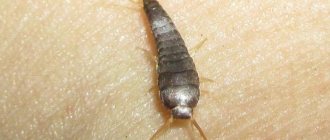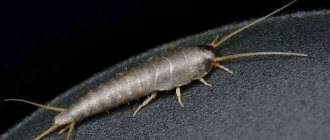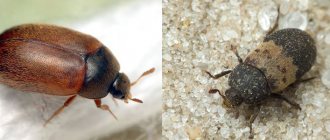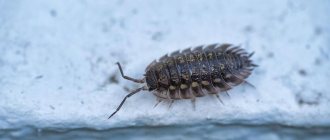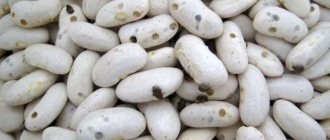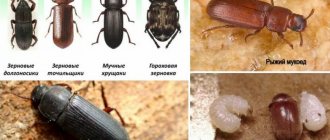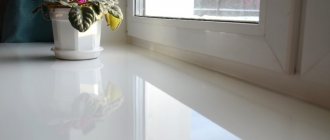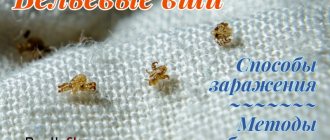Insects appear in the bathroom because suitable conditions are created there for them:
- Excessive humidity.
- Warm.
- Darkness.
- Secluded places to hide.
- Sufficient amount of food.
It would seem, what kind of food can insects find in the bathroom? Humidity-dependent species feed mainly on fungi and microflora. In addition, in bathrooms there is always an abundance of fallen hair and pieces of exfoliated skin, which can also be part of the diet of various pests.
Insects can enter the house through:
- Ventilation
- Cracks in communications
- Damage to walls, floors, ceilings
- Leaky joints in window frames
- Gaps in door frames
Parasites can enter the house accidentally on:
- Flowers and indoor plants
- Fruits, berries and herbs from the garden
- Shoes
- Pet hair
What exactly pests attach to largely depends on their species. What white insects
can be found
in the bathroom
and toilet?
Translucent insects - silverfish
Most often, small, almost flat, small bugs can be seen in the bathroom and toilet. This is a common silverfish. They come in white, pearl gray or brownish color. Immediately after molting, they are almost transparent, later becoming darker. The shape resembles an elongated triangle. Long thin antennae protrude from one and the other side of the small body (4-8 mm). The antennae are longer in front, shorter in the back. They crawl out in the dark, move quickly, and can freeze in place for a moment. These insects are harmless, do not bite, and do not pose any other threat, but they have an unpleasant appearance.
You can get rid of them by creating conditions unacceptable for life and reproduction. They thrive at temperatures from +21°C to +27°C and high humidity - above 75%. They feed on substances containing starch and polysaccharides. They usually enter residential premises with paper, napkins and other paper products. In homes they can eat bread, sugar, fabrics, flour, glue, photographs, etc.
One of the most common insects found in the bathroom is silverfish.
These insects will disappear in the bathroom only if they have nothing to eat and the room is dry and light. To reduce humidity, it is recommended to eliminate all leaks, dry all wet places (you can use a hair dryer), carefully seal the joint between the bathtub or shower tray and the wall, fill all the seams between the tiles with grout, fill all joints and cracks with silicone, and organize ventilation by installing a fan if necessary. Having completed these works, thoroughly wipe off the water after any procedures.
By maintaining low humidity in the bathroom, over time you will be able to get rid of these insects. Insect control medications can speed up the process. Regular Dichlorvos, cockroach crayons, and any other means of controlling insects in the apartment, including boric acid, also help. But if you do not eliminate the cause of their appearance - constant high humidity - they will appear again in a month.
flies
Which insects are capable of carrying pathogens and parasitic eggs and are often companions of humans? These are flies; their appearance at home, and especially near food, is unacceptable. What will help in the fight against them:
- If flies live near your apartment and fly inside, keep a fly swatter ready. Screens on windows help limit their access, like other insects.
- Hanging Velcro strips are a very effective solution. When a fly enters a room, the first thing it does is fly towards the pleasant smell of “Velcro” and does not have time to do any harm.
- Lovers of indoor plants can have geraniums, which repel flies. Sprigs of tansy placed in several places also help greatly with this.
Woodlice
Wood lice often appear in the bathroom and toilet. They are mistakenly called insects, although they belong to the class of crustaceans. It’s just that the relatives of crayfish have adapted to life on land, although they look for places with high humidity. They are easy to distinguish by their appearance - they have an oval body, convex at the top, divided into segments and covered with hard plates. The body may be light, with a slight yellowish tint, or dark brown or gray. Another distinctive feature is their behavior: in case of danger, woodlice curl up into a ball.
These insects are frequent guests in the bathroom. They are called wood lice
Woodlice feed on rotting organic matter. Spoiled vegetables, fruits, herbs are from the diet. Fungi that develop in damp areas are also suitable for them to feed on. Therefore, in addition to the bath and toilet, they can be found in the kitchen, and brought in with spoiled food. It also finds them in rooms if apartment dwellers or pets have a habit of leaving food under beds or sofas.
You can get rid of wood lice in the bathroom and toilet only by thoroughly drying the room, removing all possible sources of food. In addition to the measures described above (prevent water from getting on the floor, walls, improve ventilation), it is necessary to carry out thorough cleaning and disinfection. You can use a solution of bleach, Domestos, and other similar products for these purposes.
Bite
Each wasp has fairly powerful jaws called “mandibles.” They are used both for feeding on a variety of plant foods and for killing caught prey. For example, in the vast majority of cases, hornets, which attack even large insects like praying mantises and cockroaches, practically do not use a sting, but can simply use strong jaws, crushing the chitinous covers of their victim.
The wasp moves quite quickly, but at the same time it has far from the highest speed among insects, as a result of which even well-armed predators often end up being victims themselves. In particular, dragonflies and predatory duck flies feed on them.
How to get rid of small flies
Sometimes small (a couple of millimeters long) black or dark brown flies appear in the bathroom. They have large wings compared to the body. The body and wings are shaggy, which is why the fly sometimes appears larger than its actual size. The name of these flies is butterflies. They start in rooms with high humidity and penetrate into houses and apartments through windows, doors, ventilation ducts, and sewers.
Females lay eggs in water; after two to three weeks, larvae hatch from them, which after some time turn into winged insects. These bathroom bugs will disappear if there is no opportunity to lay eggs in a moist environment. Therefore, we carefully seal all joints and cracks, wipe off the water, and take measures to reduce humidity. In addition, the following methods help:
- Thoroughly treat the floor and all habitats of flies with tar or laundry soap, leave overnight, and wash with water in the morning.
- Wash the floor with a bleach solution, treat bathtub and sink drains. Wipe all surfaces with diluted vinegar.
Centipedes
These insects are called centipedes, flycatchers, and centipedes. They have a flat body and a large number (up to 40) of long thin legs. Thanks to their flat body, they penetrate even the smallest crevices and can move quickly. The optimal living environment for them is places with high humidity, so they also often appear in bathrooms and toilets, but they can also be found in the kitchen and living rooms.
These insects are hunting in the bathroom
These insects eat flies, cockroaches, silverfish and other small insects and go out hunting at night. In addition to insects, flycatchers can feed on half-rotten plant debris. So the proximity of centipedes helps get rid of other insects in the apartment and this is one of the methods of getting rid of insects in the bathroom. But not everyone is able to put up with such “neighbors” - their appearance is far from the most attractive. Centipedes bite, but their poison is fatal only to insects; it has no effect on humans, although the bites are unpleasant.
Millipedes are rarely poisoned; they are usually caught alone and are simply swatted away. To get rid of them and be sure that they are not in the apartment or house, it is necessary to normalize the humidity (in a private house this is not only the bath and toilet, but also the basement and attic), and eliminate food sources. Then they will leave your home on their own.
Eating methods
The class Insects is also distinguished by a variety of feeding methods. Among them you can find parasites, predators, blood-sucking, saprotrophs and herbivores. This also determines the diversity of the structure of their mouthparts. Let's remember what insects pollinate plants. These are bees and bumblebees. Their gnawing-licking oral apparatus is represented by an elongated tongue. And butterflies receive nectar with the help of a proboscis, which forms a sucking-type mouthparts.
eats plant leaves. Its gnawing apparatus is capable of grinding food. And some insects can pierce the integument of animals and plants to obtain blood or juices. These are aphids, bedbugs, mosquitoes, lice, fleas. Their mouthparts are piercing-sucking.
Preparations for controlling insects in the bathroom
Few people are happy about insects in the bathroom or toilet. I want to get rid of them right away. Even if they are harmless. That’s why many people prefer to treat with chemicals. There are a number of products in stores that can help with this:
- Aerosol against flying and crawling insects - Raid. It smells like lavender and, according to the manufacturers, is harmless to humans, so you can carry out the treatment without leaving the room. Destroys adults, has no effect on larvae or eggs.
- Medilis-Ziper. Suitable for combating most insects that may appear in a house or apartment. This is a concentrate for dilution with water (the proportions are indicated on the package). The solution is poured into a spray bottle and the product is sprayed into the room. It has a strong odor, so it is advisable to wear a respirator during processing, and afterward leave the room for several hours, after which ventilate well.
Some means of controlling insects in a house or apartment
Usually, the first meeting with a silverfish happens completely unexpectedly. You can live for years in complete confidence that you are the sole owners of your home, until, one day, far from wonderful, you suddenly meet these uninvited residents face to face.
Or rather, at night, since silverfish are nocturnal inhabitants. Where do unexpected acquaintances most often occur? In warm rooms with high humidity - bathroom, toilet, kitchen.
The appearance of silverfish is quite unpleasant - a long body of light gray or greenish color with many legs on both sides and long antennae.
If you have ever seen a silverfish in your apartment, then it’s time to figure out how to get rid of it and remove it forever.
Summarizing
Having once experienced the shock of meeting an incomprehensible bug-worm in the bathroom, which should not be there in principle, the attitude towards cleaning this room changes radically. For some reason, small animals/insects inspire superstitious fear, probably because of their ability to suddenly disappear and hide in unexpected places. After the “reclamation” of the bathroom, the only person who can wander in there is an innocent spider – a symbol of wisdom and creativity.
More information about some of the inhabitants of the bathroom can be found in the video in this article.
In the comments to the article you have the opportunity to express your opinion or share information on the topic.
Our home is a place where a person spends the main part of the day, when he wants special comfort and relaxation. Various factors can influence the appearance of insects in a human home.
That is why the appearance of uninvited “guests” can bring a lot of trouble. Particularly often insects infect two places in the apartment - the kitchen and the bathroom. The appearance of such living creatures often causes negative emotions and disgust in people; often these pests can be carriers of various infections.
The main difficulty in dealing with such pests is the fact that these insects are for the most part omnivores, which is why they are only happy to live with people under the same roof, where there is a huge amount of food.
Folk remedies
Getting rid of the pest at home is difficult, but possible.
There are three ways to do this:
- Chemicals.
- Traps.
- Homemade poisons.
- Chemical industrial products for combating silverfish include insecticides in the form of an aerosol, gel or powder.
This is the well-known Dichlorvos, easy-to-use Raptor Gel, powders based on boric acid.
Be sure to treat all corners and crevices in the walls with products. It is there that the larvae hide, from which new individuals subsequently emerge. The trap can be purchased at a hardware store. goods, or you can do it yourself. Homemade devices are good because they are absolutely harmless and environmentally friendly.
— Glass trap . Wrap a regular half-liter jar with tape or tape, and place some food inside - fresh bread crumb, a piece of apple or other sweet fruit.
Leave the jar in the corner of the bathroom. During the night, insects attracted by the smell will climb into the jar, and the slippery inner walls will prevent them from getting out. All you have to do is close the jar with a lid and destroy it in any convenient way.
— Paper trap . An even simpler option. Simply place damp, crumpled newspaper on the floor and take it to the trash container in the morning. It is strictly forbidden to unfold the paper, as the nimble pests will quickly scatter to the sides. To prepare homemade poison you will need:
— Boric acid powder, 1 part. — Crushed chalk, 4 parts.
Mix the dry ingredients and pour into all corners and along the walls of the room, after thoroughly drying the floor.
Two to three days after treatment, you will find dead insects that must be thoroughly swept out and the floor washed with water acidified with table vinegar.
Measures to “clean up” the territory
Constantly scrubbing a bathroom down to the last square millimeter is difficult, but it is possible to apply basic preventive measures . Instructions for keeping dry are as follows:
- reduce humidity - eliminate leaking taps, ensure good ventilation;
- cover the ventilation holes with fine mesh;
- seal cracks in walls, floors, and ceilings;
- use floor mats made of special materials - rubber, silicone, fiber polymers, bamboo;
- do not create deposits of dirty laundry;
- wipe surfaces weekly with chlorine-containing preparations;
- After general cleaning, thoroughly dry the room using a fan or household dehumidifier.
Desiccant with tablets
By using replaceable absorbent tablets/granules, you will save electricity. One tablet weighing 450 g is enough for a year.
Chemicals
After eliminating the causes of dampness, insecticides will become powerful means of exterminating pests in the bathroom.:
A guaranteed result is provided by professional disinfestation of the premises performed by special services, no matter what its price.
Several types of processing are used:
- cold fog;
- barrier protection;
- hot fog;
- complex.
Is it dangerous for humans?
Neither adult silverfish nor larvae pose a particular danger to human health. They do not bite and do not emit allergic substances. However, food products can be contaminated by the remains of their vital activity.
Also, the female can lay her offspring directly in a container with flour or sugar, which is very unpleasant and obviously will not benefit the prepared dishes.
But silverfish, if not destroyed in time, can cause significant harm to your favorite paper photographs or rare books and paintings.
Worms in the mattress (pillow, bed)
If you find a damaged mattress or pillow, examine the bedding for the presence of small light-colored worms - clothes moth larvae. Calling them worms is not very correct, because the caterpillar has, albeit tiny, six pairs of limbs. The clothes moth (larva), just like a furniture moth, makes a cover, constructing it from fabric and a certain substance of its own, reminiscent of silk.
Clothes moth larva – photo
With normal nutrition and optimal temperature, the larva develops in two months, and with a drop in temperature in five months. Caterpillars have a length from 1 to 12 mm; interestingly, they cannot drink, so they prefer damp areas of fabric - greasy stains, food debris, sweat. House moth larvae can be found in closets with clothes, in carpets, and other dark places.
What do silverfish eat?
Silverfish feed on starch and polysaccharide-containing substances. At risk are all bulk products stored in non-hermetically sealed containers, bread and rolls in bread bins, fruits in open vases.
The aromas of all these products attract bristletails, which shed their scales on them and leave feces in the form of small black dots. In the same way, pests can grow on bookshelves, because there are enough materials containing glue there.
Prevention measures
To prevent insects from leaving their traces in products or damaging books and other paper products, take preventive measures to prevent their appearance:
- Avoid constant moisture in storage areas.
- Clean surfaces regularly with water adding a few drops of potassium permanganate or table vinegar, and then wipe dry.
- In bathtubs, kitchens and toilets, do not forget to clean the ventilation pipe, and do not allow water to stagnate under the bathtub or sink.
- Provide air access - ventilate the room as often as possible.
- Keep food in closed containers, and hide clothes in special fabric bags.
Keep it clean, and the reason for the appearance of unpleasant crawling creatures in your home will be destroyed.
Where does the attack come from?
There are basically two objective reasons for the appearance of “tenants”:
- various types of communications - woodlice, millipedes, etc. migrate with impunity through ventilation shafts;
- interruptions in the operation of filtration systems, for example, in the tap water there may be small black worms in the bathroom - mosquito larvae.
We create the remaining prerequisites ourselves in pursuit of glamorous design or due to banal laziness, they can be:
- warm water pipes hidden in boxes under the casing; but small-timers will always find a micro-crack to squeeze through to visit you;
- condensation flowing into nooks and crannies under the bathtub that are difficult to reach;
Pandemonium in a wet corner
- damp rugs on the floor near the bathroom/toilet;
- dust;
- clogged drains;
- storage area for rags under the bathroom.
Insects in the bathroom: photos and names
One of the reasons for the presence of uninvited guests in bathrooms and toilets is a violation of the proper microclimate, which creates attractive conditions for pests, as well as basic hygiene standards indoors. In such cases, pests actively begin to penetrate from ventilation, cracks, and through balconies.
Most often, centipedes, spiders, silverfish, wood lice, and butterflies (in the photo you can see them enlarged) appear inside the bathroom or toilet, which are easy to get rid of.
White insects in the bathroom
As for the white insects in the bathing room, these could be recently shed silverfish. They are small in size (up to 10 mm), the body is slightly elongated, and has a light gray or almost transparent color. The body ends with three hairs. They run very fast.
Woodlice also acquire a white shell color during molting; during other periods of life they are gray. They are a type of crustacean. They are harmless and do not bite. Occasionally they are able to appear and spoil vegetable and fruit stocks inside pantries.
There are insects in the bathroom and toilet, tadpoles are running fast
If quickly crawling white tadpoles appear, these are common silverfish. It belongs to the small wingless species of the bristletail order. This is one of the most ancient creatures; scientists have proven that this species existed more than three hundred million years ago.
The tadpole got its name due to the presence of small silvery scales. People sometimes confuse silverfish with the centipede flycatcher, but the main difference between the second insect is the large number of long legs.
Silverfish in an apartment do not pose any threat to people and do not have a negative impact on health, but from an aesthetic point of view it is still better to get rid of them.
What is this strange beast?
The parasites that have settled in your toilet or bathroom are common silverfish. These are insects with a small oblong body, thin legs (short legs - 8 pairs, main ones - 4 pairs) and processes on the tail and head.
Silverfish belong to the order of crustaceans and resemble woodlice. These small white bugs move very quickly, penetrate into the narrowest cracks and hide if you turn on the light. They are quite tenacious and once settled, they will remain for a long time. It is useless to hope that the problem will resolve itself. Not only that, but these insects have a high reproduction rate, so the beetle population will grow larger over time!
Adult silverfish can take on different shades and be green, brown, yellow or silver. Light-colored individuals are most often found in apartments. To accurately identify them, look at these photos.
This is interesting! According to scientists, silverfish are the most ancient insects living on Earth. The structure of their body has rather primitive features that were characteristic of the ancestors of modern parasites.
The beetles are nocturnal - they crawl out to hunt in the evening, and during the day they prefer to hide away. Food products for silverfish are:
- Wallpaper glue; Natural fabrics; Mold; Food leftovers; Wet paper; Garbage under rugs and bedding; Rags.
Most of all, these bugs love dampness and humidity, and they cannot stand bright light. The bathroom perfectly matches the tastes and requirements of silverfish, so most often the parasites settle there.
White insects in the bathroom: how to get rid of them?
To combat white insects inside the bathroom and toilet, you must first decide what specific type of parasite is bothering you. And even then, in order to get rid of it, special means are selected.
Before treating the apartment, it is important to restore order inside the room, wash all plumbing equipment, furniture, floors, and walls. It is also necessary to create balanced microclimatic conditions and, if necessary, install additional ventilation and a battery. Eliminate cracks and gaps between ventilation grilles.
Remedies for small white insects in the apartment
When small white bugs run around in the toilet, it causes extremely unpleasant sensations, especially at night. Many people don’t know what to do about it and start to panic instead of quickly getting rid of it.
There are various ways to combat them, but the most important thing is to follow the recommendations to prevent excessive moisture formation.
The most effective insecticidal preparations aimed at getting rid of intrusive guests that you unexpectedly have include the following:
To get rid of insects, you can also use various chlorine-based substances; they are useful for treating corners and places where mold forms. Using copper sulfate, dry the washed walls, directing the warm air flow with a fan.
In an apartment, it is advisable to use a mixture of boric acid and chalk (1:4). Sprinkle it on all places where pests have been noticed (plinths, corners, cracks, area under the bathroom, plumbing equipment).
Mole
These insects can spoil not only things in cabinets, but also food. Moth larvae and caterpillars are found in bulk products (flour, cereals); they may also take a liking to dried fruits. Moths multiply very quickly in an apartment, so you need to start fighting them immediately after detection. What methods of combating these insects are:
- Using repellents against butterflies. This could be a chemical compound - naphthalene, or it could be herbal remedies - geranium and lavender.
- A much more pronounced result is obtained by chemical treatment, for which dichlorvos is used.
No matter what insects that are resistant to poisons and influences pester you, you can still cope with them. But if you are already desperate to do it yourself, contact a pest control specialist. These guys know their stuff and can help even in the most advanced cases.
